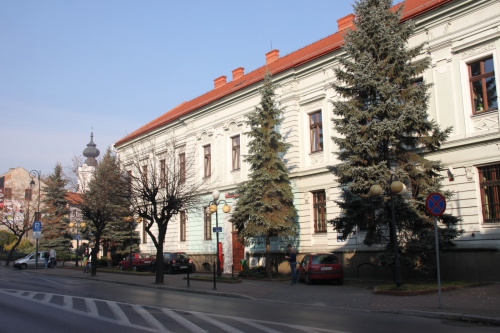The Lviv–Vienna highway was for Wadowice the main transport hub from the very moment the road was routed. In the 19th and early 20th centuries, urban development followed the routing of the road in the west-east axis. In the following decades the most important public buildings were erected along this road.
Building of the former Poviat Counciland the Poviat Savings Office
A visible symbol of the construction boom in Wadowice in the 1890s was the building of the Poviat Council and the Poviat Savings Office (1896), which is still today one of the architectural gems of the town. The building was erected according to the design of the Cracow architect, Ignacy S. Sowiński (1858-1917). At the turn of the 20th century, one of the wings of the building was occupied by the Poviat Savings Office. It was the first such institution at the county level in Galicia (1873) and it was responsible for granting loans and keeping accounts. It was also in charge of the regional branch of the National Bank of Lviv. Before the outbreak of the First World War, the building also housed the base of the First Scout Troop named after S. Żołkiewski, among the active members of which were Józef Herzog (1902-1983) and Wincenty Bogdanowski (1894-1982). Herzog was a soldier of the Polish Legions (from 1915) and then of the 56th Infantry Regiment of the Austrian army (from 1917). When the battle for the borders of the Second Republic of Poland was over, he served in the Polish Army. During the period of communist rule, he founded the secret Union of Polish Legionnaires in Cracow. As a student of the Wadowice Gymnasium, Bogdanowski served in the function of Team Leader in the First Scout Troop of Wadowice. In later years he was the Vice Mayor of Cracow and an activist of the Polish Peoples’ Party.
Teofil Wysogląd’s restaurant, hotel and theatre cinema
Opposite the Savings Office building, a posthouse was built (1805); later on, it was rebuilt (1900) and housed T. Wysogląd’s restaurant. At the rear, the Clerks’ Reading-Room, also named the Official (Municipal) Casino was established. In January 1915 this place was visited by Józef Piłsudski, who was travelling via Wadowice with his legionnaires. The ‘U Wysogląda’ (‘At Wysogląd’s’) was a venue for events on various festive occasions, such as student balls (‘Studniówki’, i.e. the traditional balls held approximately a hundred days before the schoolleaving examinations); also theatre plays were performed here. During the First World War, the inhabitants of Wadowice wanted to create at least an impression of ‘normality’; and so, around late 1915 and early 1916 a cinema-theatre was established at the restaurant. The repertoire included films such as, Quo vadis (1915), Alexander (1916), Matyl (1917), The Last Days of Pompeii (1917) and Cleopatra (1917). A regular visitor to the Clerks’ Reading-Room was Jan Doroziński (1862-1942), a professor and director at the Gymnasium in Wadowice. It was there that he followed his passion for chess. In 1908, in Cracow, he won (as the only one) a game against the later American chess champion, Frank Marshall.

